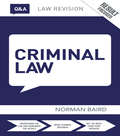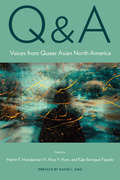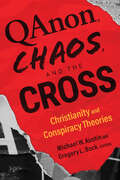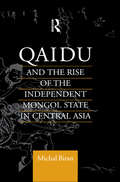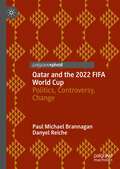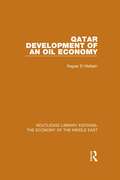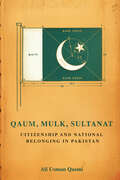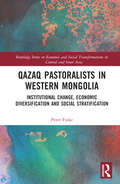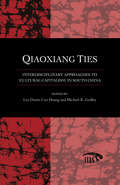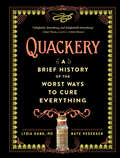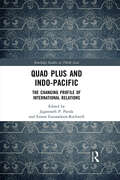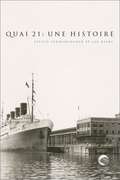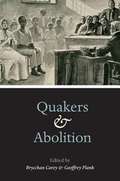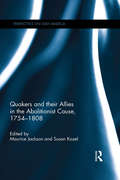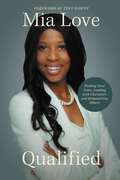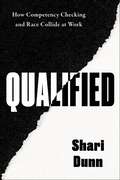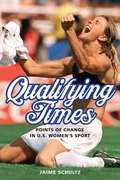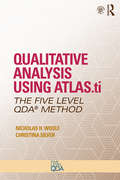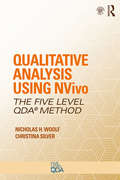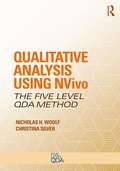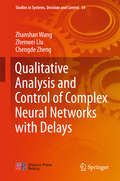- Table View
- List View
Pädagogische Qualität in Waldorfkindergärten und Waldorfkrippen: Eine qualitative empirische Studie zu spezifischen Qualitätsmerkmalen aus Sicht beteiligter Erwachsener
by Philipp GelitzWaldorfkindergärten und Waldorfkrippen stellen trotz ihres jahrzehntelangen Bestehens noch immer eine Forschungslücke dar. Neben vielen Publikationen zu Intentionen und Annahmen der vorschulischen Waldorfpädagogik gibt es weltweit fast gar keine empirischen Untersuchungen vorzuweisen. Diese Lücke soll die vorliegende Forschungsarbeit anfänglich schließen. Den Bezugsrahmen der Untersuchung bilden einerseits die erziehungswissenschaftlichen Diskurslinien um pädagogische Qualität in frühpädagogischen Einrichtungen und andererseits die theoretischen Grundpfeiler der Waldorfpädagogik. Vor diesem Hintergrund wird ein qualitatives Forschungsdesign entwickelt, das die beteiligten Erwachsenen im Feld – Fachkräfte, Dozierende und Eltern – nach besonderen Schwerpunkten der pädagogischen Qualität in Waldorfeinrichtungen befragt. Dabei kann gezeigt werden, dass es Merkmale gibt, wie z.B. bestimmte Annahmen über den Menschen, von der Bedeutung des freien Spiels, von Rhythmus, von sinnlichem Erleben und viele weitere, die für Waldorfkrippen und Waldorfkindergärten spezifisch zu sein scheinen. Die Arbeit hebt durch die Befragung einen Schatz an bisher verborgenem Handlungswissen, was sie zu einem Ausgangspunkt für viele weitere Forschungen und Hypothesenprüfungen macht.
Q&A Criminal Law: Q And A Criminal Law 2011-2012 (Questions and Answers)
by Norman BairdRoutledge Q&As give you the tools to practice and refine your exam technique, showing you how to apply your knowledge to maximum effect in an exam situation. Each book contains up to fifty essay and problem-based questions on the most commonly examined topics, complete with expert guidance and fully worked model answers. These books provide you with the skills you need for your exams by: Helping you to be prepared: each title in the series has an introduction presenting carefully tailored advice on how to approach assessment for your subject Showing you what examiners are looking for: each question is annotated with both a short overview on how to approach your answer, as well as footnoted commentary that demonstrate how model answers meet marking criteria Offering pointers on how to gain marks, as well as what common errors could lose them: ‘Aim Higher’ and ‘Common Pitfalls’ offer crucial guidance throughout Helping you to understand and remember the law: diagrams for each answer work to illuminate difficult legal principles and provide overviews of how model answers are structured Books in the series are also supported by a Companion Website that offers online essay-writing tutorials, podcasts, bonus Q&As and multiple-choice questions to help you focus your revision more effectively. Criminal Law Q&A covers the general principles of criminal law, homicide, non-fatal offences against the person and sexual offences, general defences, modes of participation, inchoate offences and vicarious liability, and offences against property.
Q&A: Voices from Queer Asian North America (Asian American History & Cultu)
by Martin F. Manalansan IV, Alice Y. Hom, and Kale Bantigue FajardoFirst published in 1998, Q & A: Queer in Asian America, edited by David L. Eng and Alice Y. Hom, became a canonical work in Asian American studies and queer studies. This new edition of Q & A is neither a sequel nor an update, but an entirely new work borne out of the progressive political and cultural advances of the queer experiences of Asian North American communities. The artists, activists, community organizers, creative writers, poets, scholars, and visual artists that contribute to this exciting new volume make visible the complicated intertwining of sexuality with race, class, gender, and ethnicity. Sections address activism, radicalism, and social justice; transformations in the meaning of Asian-ness and queerness in various mass media issues of queerness in relation to settler colonialism and diaspora; and issues of bodies, health, disability, gender transitions, death, healing, and resilience. The visual art, autobiographical writings, poetry, scholarly essays, meditations, and analyses of histories and popular culture in the new Q & Agesture to enduring everyday racial-gender-sexual experiences of mis-recognition, micro-aggressions, loss, and trauma when racialized Asian bodies are questioned, pathologized, marginalized, or violated. This anthology seeks to expand the idea of Asian and American in LGBTQ studies. Contributors: Marsha Aizumi, Kimberly Alidio, Paul Michael (Mike) Leonardo Atienza, Long T. Bui, John Paul (JP) Catungal, Ching-In Chen, Jih-Fei Cheng, Kim Compoc, Sony Coráñez Bolton, D’Lo, Patti Duncan, Chris A. Eng, May Farrales, Joyce Gabiola, C. Winter Han, Douglas S. Ishii, traci kato-kiriyama, Jennifer Lynn Kelly, Mimi Khúc, Anthony Yooshin Kim, Việt Lê, Danni Lin, Glenn D. Magpantay, Leslie Mah, Casey Mecija, Maiana Minahal, Sung Won Park, Thea Quiray Tagle, Emily Raymundo, Vanita Reddy, Eric Estuar Reyes, Margaret Rhee, Thomas Xavier Sarmiento, Pahole Sookkasikon, Amy Sueyoshi, Karen Tongson, Kim Tran, Kay Ulanday Barrett, Reid Uratani, Eric C. Wat, Sasha Wijeyeratne, Syd Yang, Xine Yao, and the editors
QAnon, Chaos, and the Cross: Christianity and Conspiracy Theories
by Edited by Michael W. Austin and Gregory L. Bock&“What is truth?&” said jesting Pilate, and would not stay for an answer. —Francis Bacon Although Christians are followers of the Truth, many find themselves tempted by the alternate &“truths&” offered by conspiracy theories. Christianity and conspiracy theories have had a long, complicated relationship. But today conspiracy theories are bringing our already polarized society to the brink of chaos. QAnon, the Big Lie, and anti-vaccination theories thrive online, disrupting faith communities. This timely essay collection explores the allure of conspiracy theories and their consequences—and ultimately offers gospel-based paths forward. Accessible to all concerned believers, QAnon, Chaos, and the Cross features scholars of religion, ethics, and public life on the following topics: • evaluating evidence and forming beliefs • the Satanic Panic of the 1960s–1990s • understanding scientific methodology • conspiracy theories&’ appeal to those searching for meaning • the consequences of social media and echo chambers • productive dialog with people who hold different opinions • intellectualism in the life of faith • conspiracy theories in Scripture • QAnon&’s religious rhetoric Complete with a guide to reasoning, which outlines both logical fallacies and intellectual virtues, QAnon, Chaos, and the Cross is an indispensable resource for all Christians seeking the truth. Contributors:Chase Andre, Michael W. Austin, Bradley Baurain, Daniel Bennett, Gregory L. Bock, Chad Bogosian, Kevin Carnahan, Jason Cook, Scott Culpepper, Stephen Davis, Garrett J. Deweese, Marlena Graves, Shawn Graves, David Horner, Dru Johnson, Nathan King, Rick Langer, Christian Miller, Timothy Muehlhoff, Michelle Lynn Panchuk, Susan Peppers-Bates, Steven Porter, Kaitlyn Schiess, Aaron Simmons, Domonique Turnipseed, Rachel I. Wightman, Keith Wyma, Eric Yang
QAnon: From Conspiracy Theory to New Religious Movement (Routledge Studies in Fascism and the Far Right)
by Marc-André ArgentinoThis book explores the QAnon movement by examining its history, fluctuations, and evolution, stemming from the likelihood of multiple users behind the “Q” account, as well as from the changes in the sociopolitical landscape since the creation of the movement. It frames QAnon as a lived religion and demonstrates that it has gone through three stages of existence: proto-QAnon, canonical-QAnon, and apocryphal-QAnon.Author Marc-André Argentino argues that QAnon evolved into something more than a conspiracy theory and demonstrates through a comparative analysis that QAnon is more akin to a new religious movement, in particular a hyper-real religion. He explores the role of gender and women in the QAnon movement, followed by an examination of how the QAnon conspiracy theories have legitimized and coordinated targeted gender-based violence. The book provides evidence of the nexus of QAnon and ideologically-motivated violent extremism and criminality. Finally, it examines the evolution of QAnon after the January 6th insurrection, the loss of the 2020 election by Donald Trump, and the disappearance of “Q.” This volume will be of great interest to researchers of conspiracy theories, new religious movements, American politics, and extremism.
QCA with R: A Comprehensive Resource
by Adrian DuşaThis book is a comprehensive guide to qualitative comparative analysis (QCA) using R. Using Boolean algebra to implement principles of comparison used by scholars engaged in the qualitative study of macro social phenomena, QCA acts as a bridge between the quantitative and the qualitative traditions. The QCA package for R, created by the author, facilitates QCA within a graphical user interface. This book provides the most current information on the latest version of the QCA package, which combines written commands with a cross-platform interface. Beginning with a brief introduction to the concept of QCA, this book moves from theory to calibration, from analysis to factorization, and hits on all the key areas of QCA in between. Chapters one through three are introductory, familiarizing the reader with R, the QCA package, and elementary set theory. The next few chapters introduce important applications of the package beginning with calibration, analysis of necessity, analysis of sufficiency, parameters of fit, negation and factorization, and the construction of Venn diagrams. The book concludes with extensions to the classical package, including temporal applications and panel data. Providing a practical introduction to an increasingly important research tool for the social sciences, this book will be indispensable for students, scholars, and practitioners interested in conducting qualitative research in political science, sociology, business and management, and evaluation studies. <P><P><i>Advisory: Bookshare has learned that this book offers only partial accessibility. We have kept it in the collection because it is useful for some of our members. Benetech is actively working on projects to improve accessibility issues such as these.</i>
Qaidu and the Rise of the Independent Mongol State In Central Asia (Central Asia Research Forum)
by Michal BiranQaidu (1236-1301), one of the great rebels in the history of the Mongol Empire, was the grandson of Ogedei, the son Genghis Khan had chosen to be his heir. This boof recounts the dynastic convolutions and power struggle leading up to his rebellion and subsequent events.
Qatar and the 2022 FIFA World Cup: Politics, Controversy, Change
by Danyel Reiche Paul Michael BrannaganThis book offers the first, full academic analysis of the Qatar 2022 FIFA World Cup. Adopting an international relations perspective, the authors critically interrogate the politics and controversy that has surrounded arguably the most controversial sports event ever. In doing so, this text offers up an imperative examination of Qatar’s desired objectives through their investment in global sport and sports events, as well as provides readers with an academic explanation on why major event hosts – such as Qatar – receive so much international scrutiny in the pre-event stage of the event hosting process. On the back of this international scrutiny, this text also provides the first full analysis on how such negative scrutiny has forced Qatar to implement various social-political changes at home.
Qatar: Development of an Oil Economy (Routledge Library Editions: The Economy of the Middle East)
by Ragaei el MallakhNo region in the world has seen so much development activity in the last ten years as the Gulf area. Since ‘black gold’ catapulted the oil-producing countries into the limelight of the international political and economic scene, there has been a proliferation of studies on the larger exporting states. However, many of the so-called ‘small countries’ have been neglected in this exercise. This book presents the first detailed examination of the bases and extent of economic development in Qatar and considers the need to translate the petroleum-generated growth into viable, self-sustained development. Qatar, though not one of the oil ‘giants’, was first in the field of oil development and exhibits a number of special features not shared by its Gulf neighbours: for example in pre-oil boom days it was already in advance of many other Gulf states in the field of education; it has a modest agriculture sector and there is a comparatively strong attachment to the land; and finally it has played an important role in OPEC as a member of the ‘moderate price’ camp. The individual chapters trace the development of the oil industry, outline public financing and economic policy and sketch the issues involved in industrialisation, absorptive capacity and agricultural development. Examination is made of the social and physical infrastructure as well as money and banking, and the international linkages in trade, foreign aid, economic cooperation efforts and investment opportunities are elucidated. Planners in Qatar know that their revenue base in petroleum is finite, and thus investment of present surplus needs careful planning. The book therefore also outlines current government priorities and suggests areas for future investments. First published in 1979.
Qaum, Mulk, Sultanat: Citizenship and National Belonging in Pakistan (South Asia in Motion)
by Ali Usman QasmiAfter the trauma of mass violence and massive population movements around the partition of India and Pakistan in 1947, both new nation states faced the enormous challenge of creating new national narratives, symbols, and histories, as well as a new framework for their political life. While leadership in India claimed the anti-colonial movement, Gandhi, and a civilizational legacy in the subcontinent, the new political elite in Pakistan were faced with a more complex task: to carve out a separate and distinct Muslim history and political tradition from a millennium long history of cultural and religious interaction, mixing, and coexistence. Drawing on a rich archive of diverse sources, Ali Qasmi traces the complex development of ideas of citizenship and national belonging in the postcolonial Muslim state, offering a nuanced and sweeping history of the country's formative period. Qasmi paints a rich picture of the long, arduous, and often conflict-ridden process of writing a democratic constitution of Pakistan, while simultaneously narrating the invention of a range of new rituals of state—such as the exact color of the flag, the precise date of birth of the national poet of Pakistan, and the observation of Eid as a "national festival"—providing an illuminating analysis of the practices of being Pakistani, and a new portrait of Muslim history in the subcontinent.
Qazaq Pastoralists in Western Mongolia: Institutional Change, Economic Diversification and Social Stratification (Routledge Series on Economic and Social Transformations in Central and Inner Asia)
by Peter FinkeTaking the case of Qazaq Pastoralists in Western Mongolia, this book looks at the universal human requirement to balance individual flexibility and strategies designed to make a living with the social expectations that impose particular rules of conduct but also enable mutual trust and cooperation to emerge. Pastoralists in Western Mongolia have experienced dramatic changes in recent decades, including the dismantling of the socialist economy, a series of natural disasters, and an emigration of roughly half of the local Qazaq minority to the newly independent state of Qazaqstan. Four aspects illustrate the chances and challenges that people face. First is the emergence of the market as the dominant mode of production and exchange, a thorny way full of uncertainties. Second is the individual household and its adaptation to the new economic system, creating new opportunities as well as precarities, and resulting in rapid social stratification. Thirdly, patterns of pastoral land allocation highlight problems of collective action and institutional fragmentation in the wake of a retreating state apparatus. Finally, social networks of mutual support and cooperation constitute a key component of pastoral livelihood but are under great pressure due to short time horizons and a lack of trust. The first longitudinal analysis of the Qazaqs in Mongolia in English and a contribution to anthropological theories on human adaptability and decision-making, economic and social inequalities, institutional change and the difficulty of deriving at cooperative solutions, this book will be a standard work and of interest to academics in the field of Central Asian Studies, Anthropology, Human Geography and Development Studies.
Qiaoxiang Ties
by DouwFirst Published in 1999. Routledge is an imprint of Taylor & Francis, an informa company.
Quackery: A Brief History of the Worst Ways to Cure Everything
by Lydia Kang Nate PedersenWhat won’t we try in our quest for perfect health, beauty, and the fountain of youth? Well, just imagine a time when doctors prescribed morphine for crying infants. When liquefied gold was touted as immortality in a glass. And when strychnine—yes, that strychnine, the one used in rat poison—was dosed like Viagra. Looking back with fascination, horror, and not a little dash of dark, knowing humor, Quackery recounts the lively, at times unbelievable, history of medical misfires and malpractices. Ranging from the merely weird to the outright dangerous, here are dozens of outlandish, morbidly hilarious “treatments”—conceived by doctors and scientists, by spiritualists and snake oil salesmen (yes, they literally tried to sell snake oil)—that were predicated on a range of cluelessness, trial and error, and straight-up scams. With vintage illustrations, photographs, and advertisements throughout, Quackery seamlessly combines macabre humor with science and storytelling to reveal an important and disturbing side of the ever-evolving field of medicine.
Quad Plus and Indo-Pacific: The Changing Profile of International Relations (Routledge Studies on Think Asia)
by Jagannath P. PandaThis book explores how the Quad Plus mechanism is set to reshape the global multilateral economic and security co-operations between Quad partner countries and the rest of the world. With the Quad partners – Australia, India, Japan and the United States – seeing deteriorating ties with China, the book provides a holistic understanding of the reasons why Quad Plus matters and what it means for the post-COVID Indo-Pacific and Asian order. It goes beyond the existing literature of the global Post-COVID reality and examines how Quad Plus can grow and find synergy with national and multilateral Indo-Pacific initiatives. The chapters analyze the mechanism’s uncharacteristic yet active approach of including countries like South Korea, Israel, Brazil, New Zealand and ASEAN/Vietnam for their successful handling of the pandemic crisis, thereby reshaping the new world’s geopolitical vision. A unique study focused solely on the intricacies and the broader dialogue of the ‘Quad Plus’ narrative, the book caters to strategic audiences as well as academics researching International Relations, Politics, and Indo-Pacific and Asian Studies.
Quai 21: Une histoire (Mercure #5)
by Jan Raska Steven SchwinghamerEntre 1928 et 1971, près d’un million de personnes ont immigré par bateau au Canada, débarquant au Quai 21 d’Halifax, en Nouvelle-Écosse. Quai 21 : Une histoire (également disponible en anglais : Pier 21: A History) porte sur l’histoire de cet important centre d’immigration maritime canadien durant ses années d’activité et, ultérieurement, en tant que site de commémoration publique. Entre 1928 et 1971, presque un million d’immigrants sont arrivés par bateau au Canada, plus précisément au Quai 21, situé à Halifax en Nouvelle-Écosse. Durant toute cette période, le Quai 21 fut une des principales « portes d’entrée du Canada»; ce fut aussi le point de débarquement de presque 400 000 soldats canadiens qui rentraient au pays après avoir effectué leur service militaire en Europe durant la Seconde Guerre mondiale. Dans la période de l’immédiat après-guerre, le Quai 21 est devenu la porte d’entrée maritime la plus active au Canada. Aujourd’hui encore, de nombreux Canadiens entretiennent des liens particuliers avec le Quai 21, et ce, à travers leurs antécédents familiaux ou les récits d’arrivée de leurs parents sur le site du Quai 21. Depuis 1998, les chercheurs du Centre d’interprétation du Quai 21 et du Musée canadien de l’immigration ont mené de très nombreuses entrevues, examiné d’innombrables documents d’archives, compilé des récits écrits par des immigrants et acquis des photographies, des documents et d’autres objets emblématiques de l’histoire du Quai 21. Richement illustré, ce livre est le produit de ce long et patient travail de collecte. Il révèle l’histoire de cet immense hangar maritime canadien durant ses années d’activité et, ultérieurement, en tant que lieu historique national, musée et site mémoriel ouvert au grand public.
Quaker Women: Personal Life, Memory and Radicalism in the Lives of Women Friends, 1780–1930 (Women's and Gender History)
by Sandra Stanley HoltonOne nineteenth-century commentator noted the ‘public’ character of Quaker women as signalling a new era in female history. This study examines such claims through the story of middle-class women Friends from among the kinship circle created by the marriage in 1839 of Elizabeth Priestman and the future radical Quaker statesman, John Bright. The lives discussed here cover a period from the late eighteenth to the early twentieth centuries, and include several women Friends active in radical politics and the women’s movement, in the service of which they were able to mobilise extensive national and international networks. They also created and preserved a substantial archive of private papers, comprising letters and diaries full of humour and darkness, the spiritual and the mundane, family confidences and public debate, the daily round and affairs of state. The discovery of such a collection makes it possible to examine the relationship between the personal and public lives of these women Friends, explored through a number of topics including the nature of Quaker domestic and church cultures; the significance of kinship and church membership for the building of extensive Quaker networks; the relationship between Quaker religious values and women’s participation in civil society and radical politics and the women’s rights movement. There are also fresh perspectives on the political career of John Bright, provided by his fond but frank women kin. This new study is a must read for all those interested in the history of women, religion and politics.
Quakers and Abolition
by Brycchan Carey Geoffrey PlankThis collection of fifteen insightful essays examines the complexity and diversity of Quaker antislavery attitudes across three centuries, from 1658 to 1890. Contributors from a range of disciplines, nations, and faith backgrounds show Quaker's beliefs to be far from monolithic. They often disagreed with one another and the larger antislavery movement about the morality of slaveholding and the best approach to abolition. Not surprisingly, contributors explain, this complicated and evolving antislavery sensibility left behind an equally complicated legacy. While Quaker antislavery was a powerful contemporary influence in both the United States and Europe, present-day scholars pay little substantive attention to the subject. This volume faithfully seeks to correct that oversight, offering accessible yet provocative new insights on a key chapter of religious, political, and cultural history. Contributors include Dee E. Andrews, Kristen Block, Brycchan Carey, Christopher Densmore, Andrew Diemer, J. William Frost, Thomas D. Hamm, Nancy A. Hewitt, Maurice Jackson, Anna Vaughan Kett, Emma Jones Lapsansky-Werner, Gary B. Nash, Geoffrey Plank, Ellen M. Ross, Marie-Jeanne Rossignol, James Emmett Ryan, and James Walvin.
Quakers and Their Allies in the Abolitionist Cause, 1754-1808 (Perspectives on Early America #1)
by Susan Kozel Maurice JacksonThis volume explores the significant connections between the Quaker community and the abolitionist cause in America. The case studies that make up the collection mainly focus on the greater Philadelphia area, a hotbed of the abolitionist movement and the location of the first American abolition society founded in 1775. Despite the importance of Quakers to the abolitionist movement, their significance has been largely overlooked in the existing historiography. These studies will be of interest to scholars of slavery and abolition, religious history, Atlantic studies and American social and political history.
Qualified: Finding Your Voice, Leading with Character, and Empowering Others
by Mia LoveThis memoir from the first Black Republican congresswoman in America shows readers how to own their stories, find their voices, and lead with character as they empower others to do the same. For so long, women—and Black women in particular—have been taught that they must have a stellar background, the highest degree of education, and the strongest resumé imaginable to earn their place in a society historically dominated by white men. As a result, women have found themselves plagued with anxiety and self-doubt and have felt constricted by this limiting belief of qualification by achievement and the necessity of sporting a flawless track record. These false assumptions have discouraged women from pursuing positions of power and influence for the betterment of their communities, leading to underrepresentation in our institutions and the tragedy of wasted potential. But it doesn&’t have to be this way. Mia Love has devoted her entire life to defeating illusive boundaries and redefining the meaning of &“qualified.&” The daughter of immigrant parents who sacrificed everything to embrace the American Dream, Love learned that she had something unique and valuable that she could give back to her country—her voice. And now she wants to empower others to do the same. For years, Love faced intense scrutiny and fielded questions regarding her political party affiliation, her desire to run for office, and her commitment to championing conservative values. In Qualified, Love explains her answers to these questions by taking readers through her journey from election to her local city council, leading as mayor of Saratoga Springs, and making history in the U.S. House of Representatives serving Utah&’s 4th Congressional District from 2015–2019. Her story showcases how we can stay true to our integrity, fearlessly voice our values despite fervent opposition, and begin again after every failure and setback.
Qualified: How Competency Checking and Race Collide at Work
by Shari DunnA groundbreaking work challenging the false narrative that diversity equals a lack of qualifications by uncovering the impact of “competency checking,” a practice that unjustly scrutinizes Black people and other people of color, forcing them to repeatedly prove their worth, intelligence, and even their right to be in the workplace.The advancement of Black and other people of color in the workplace is under attack as there is a turn away from the promise of the "racial reconciliation" of 2020. This period saw Black talent rise in the workplace from DEI managers to CEOs to junior-level hires. Yet, the post-2020 workplace is seeing an alarming retreat from creating workplaces and leadership that reflect the nation’s diversity.That retreat is characterized by underemployment, cracked glass cliffs, toxic work environments, and claims of “empty pipelines.” More concerning, Black professionals and other people of color often face greater scrutiny than their peers regarding job applications, work experience, and qualifications to even be considered for employment or advancement. And that scrutiny has a name: Competency Checking.When it comes to hiring Black talent, the pipeline isn’t broken; rather, it is the assumptions we make about who is competent and qualified. In Qualified, award-winning executive and journalist Shari Dunn combines deep research with enlightening interviews and anecdotes from across the broad spectrum of her career to uncover the history of Competency Checking, how it manifests in the workplace, and what can be done to change it. Competency checking, Dunn argues, continues to be practiced consciously and unconsciously and is the key reason why Black people and other people of color are underrepresented in so many industries and why there continues to be a revolving door of Black talent even after the hiring surges of 2020.
Qualifying Times: Points of Change in U.S. Women's Sport
by Jaime SchultzThis perceptive, lively study explores U.S. women's sport through historical "points of change": particular products or trends that dramatically influenced both women's participation in sport and cultural responses to women athletes. Beginning with the seemingly innocent ponytail, the subject of the Introduction, scholar Jaime Schultz challenges the reader to look at the historical and sociological significance of now-common items such as sports bras and tampons and ideas such as sex testing and competitive cheerleading. Tennis wear, tampons, and sports bras all facilitated women's participation in physical culture, while physical educators, the aesthetic fitness movement, and Title IX encouraged women to challenge (or confront) policy, financial, and cultural obstacles. While some of these points of change increased women's physical freedom and sporting participation, they also posed challenges. Tampons encouraged menstrual shame, sex testing (a tool never used with male athletes) perpetuated narrowly-defined cultural norms of femininity, and the late-twentieth-century aesthetic fitness movement fed into an unrealistic beauty ideal. Ultimately, Schultz finds that U.S. women's sport has progressed significantly but ambivalently. Although participation in sports is no longer uncommon for girls and women, Schultz argues that these "points of change" have contributed to a complex matrix of gender differentiation that marks the female athletic body as different than--as less than--the male body, despite the advantages it may confer.
Qualitative Analysis Using ATLAS.ti: The Five-Level QDA™ Method (Developing Qualitative Inquiry)
by Christina Silver Nicholas H. WoolfSoftware is cut-and-dried – every button you press has a predictable effect – but qualitative analysis is open-ended and unfolds in unpredictable ways. This contradiction is best resolved by separating analytic strategies – what you plan to do – from software tactics – how you plan to do it. Expert ATLAS.ti users have unconsciously learned to do this. The Five-Level QDA® method unpacks the process so that you can learn it consciously and efficiently. The first part of the book explains how the contradiction between analytic strategies and software tactics is reconciled by "translating" between them. The second part provides both an in-depth description of how ATLAS.ti works and comprehensive instruction in the five steps of "translation". these steps are illustrated with examples from a variety of research projects. The third part contains real-world qualitative research projects from a variety of disciplines, methodologies, and kinds of qualitative analysis, all illustrated in ATLAS.ti using the Five-Level QDA method. The book is accompanied by three sets of videos demonstrations on the Companion Website. While this book uses screenshots from the current ATLAS.ti Version 8, it is still fully applicable to users of older versions.The book and accompanying videos illustrate the Windows version of ATLAS.ti. As there are some differences in screen and interface design between the Mac and Windows versions please watch the video 'The ATLAS.ti Mac Interface' in the Component Orientation series of videos (available September 2017)The Five-Level QDA method is based on the authors’ combined 40 years of experience teaching ATLAS.ti and other software packages used as platforms for conducting qualitative analysis. After many years observing their students’ challenges they developed the Five-Level QDA method to describe the process that long-time ATLAS.ti experts unconsciously adopt. The Five-Level QDA method is independent of software program or methodology, and the principles apply to any type of qualitative project. Please see the following URL to access the accompanying materials for this book: https://www.qdaservices.co.uk/five-level-qda
Qualitative Analysis Using NVivo: The Five-Level QDA® Method (Developing Qualitative Inquiry)
by Christina Silver Nicholas H. WoolfSoftware is cut and dried – every button you press has a predictable effect – but qualitative analysis is open ended and unfolds in unpredictable ways. This contradiction is best resolved by separating analytic strategies – what you plan to do – from software tactics – how you plan to do it. Expert NVivo users have unconsciously learned to do this. The Five-Level QDA® method unpacks the process so that you can learn it consciously and efficiently. The first part of the book explains how the contradiction between analytic strategies and software tactics is reconciled by "translating" between them. The second part provides both an in-depth description of how NVivo works and comprehensive instruction in the five steps of "translation". These steps are illustrated with examples from a variety of research projects. The third part contains real-world qualitative research projects from a variety of disciplines, methodologies, and kinds of qualitative analysis, all illustrated in NVivo using the Five-Level QDA method. The book is accompanied by three sets of video demonstrations on the companion website.The book and accompanying videos illustrate the Windows version of NVivo. As there are some differences in screen and interface design between the Mac and Windows versions please watch the video 'The NVivo Mac Interface' in the Component Orientation series of videos (available on the companion website).The Five-Level QDA method is based on the authors’ combined 40 years of experience teaching NVivo and other software packages used as platforms for conducting qualitative analysis. After many years observing their students’ challenges they developed the Five-Level QDA method to describe the process that long-time NVivo experts unconsciously adopt. The Five-Level QDA method is independent of software program or methodology, and the principles apply to any type of qualitative project.Please see the following URL to access the accompanying materials for this book: https://www.qdaservices.co.uk/five-level-qda
Qualitative Analysis Using Nvivo: The Five-Level QDA® Method (Developing Qualitative Inquiry)
by Christina Silver Nicholas H. WoolfThis long, long labor of love would have never reached fruition without the enthusiastic support of many people. Jan Morse believed in the project when it was still a germinating seed, and it would not have happened without her encouragement. Trena Paulus stands out for critiquing early drafts, asking if she could test the Five- Level QDA method at the University of Georgia and inviting us to join her and Elizabeth Pope in their research of the use of the method.
Qualitative Analysis and Control of Complex Neural Networks with Delays
by Zhanshan Wang Zhenwei Liu Chengde ZhengThis book focuses on the stability of the dynamical neural system, synchronization of the coupling neural system and their applications in automation control and electrical engineering. The redefined concept of stability, synchronization and consensus are adopted to provide a better explanation of the complex neural network. Researchers in the fields of dynamical systems, computer science, electrical engineering and mathematics will benefit from the discussions on complex systems. The book will also help readers to better understand the theory behind the control technique and its design.

